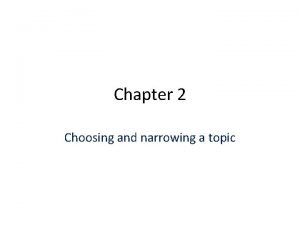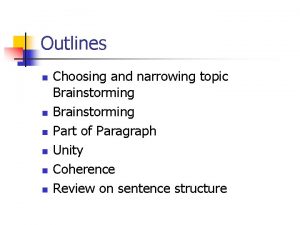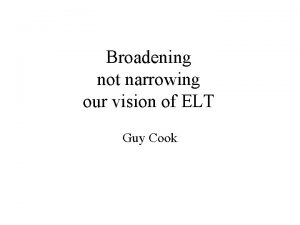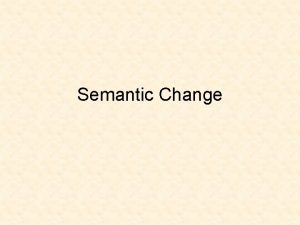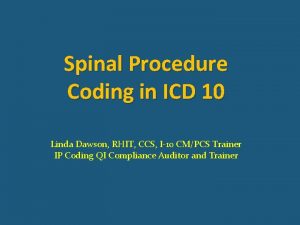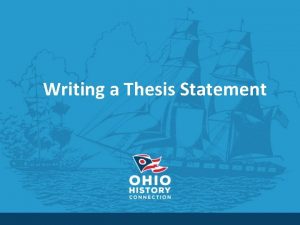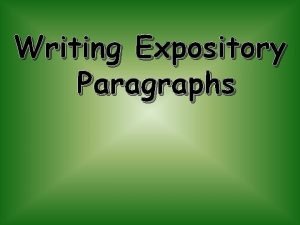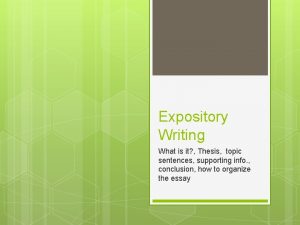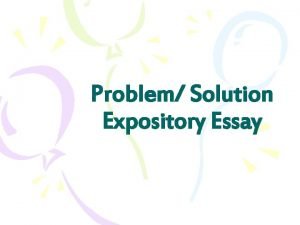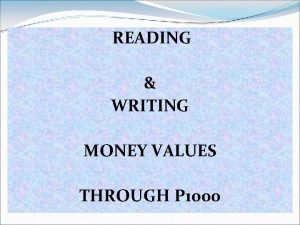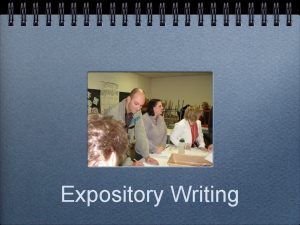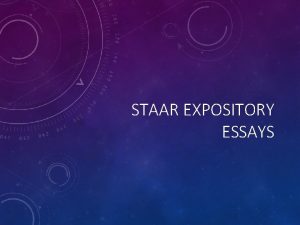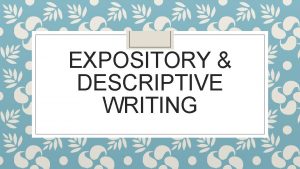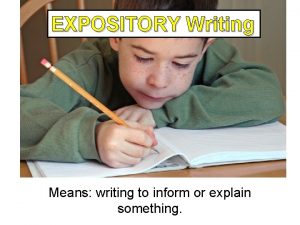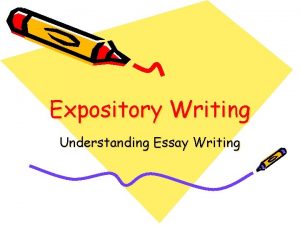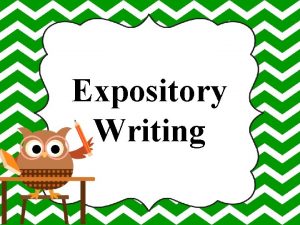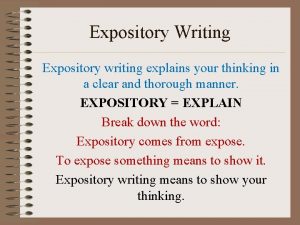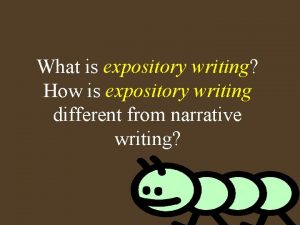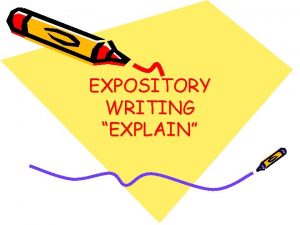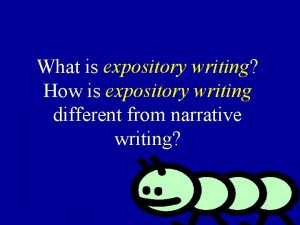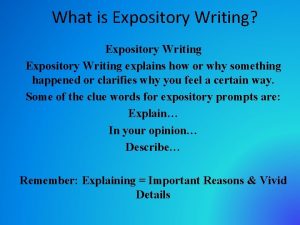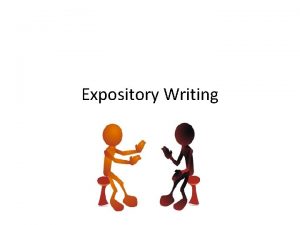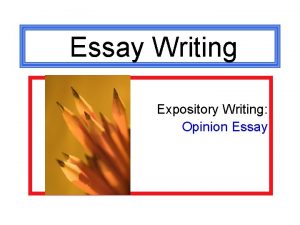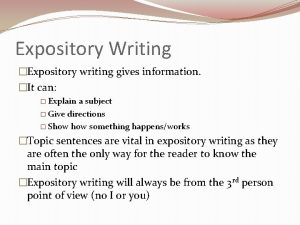Expository Writing and Reading Narrowing your Sources topic































- Slides: 31

Expository Writing and Reading

Narrowing your Sources topic

Where do I find information? A. Search engine B. Library catalog (Destiny) C. Cobb Virtual Library D. Books a. Table of contents b. Index

Guidelines for evaluating sources A. Make sure the information is accurate 1. Check author’s background to see if he/she is an expert ◦ http: //zapatopi. net/treeoctopus/ B. Use more than source to verify, or confirm facts 1. If two sources contradict each other, check a third. 2. Especially with internet sources C. Check that the source is unbiased, or fair 1. Avoid sources with an author who has a special interest in a topic D. Use information that is current, or up-to-date 1. Check publication dates of source 2. Want most recent information E. Source should apply, or be relevant to your topic III. Preview a book’s table of contents, index, and bibliography

Citations A. Document where you found the information presented in report. B. Important for two reasons a. To show that your report has a solid foundation b. To guide readers if they wish to research the topic further C. What must be cited a. Direct quotations b. Facts that are not common knowledge c. Ideas that are not your own

Parenthetical Documentation A. Includes source information directly in the body of the report. B. Put at the end of the sentence that contains relevant information. 1. Author name or source followed by the page number in parentheses before the closing period (Jones 18). 2. If using an internet source, cite the author’s last name and PARAGRAPH number (Smith par 15). 3. If there are several sentences, insert PD at the end.

Primary and Secondary Sources

Primary and Secondary Sources C. Primary Sources 1. Primary Source -an account of an experience written by a participant or an eyewitness 2. Diaries and journals 3. Speeches 4. Letters 5. Autobiographies and memoirs ◦ http: //www. cruisecritic. com/news. cfm? ID=4712 D. Secondary Sources 1. Secondary Source – an account written by someone who was not a participant or an eyewitness 2. Textbooks 3. Biographies 4. Encyclopedias 5. History Books

Paraphrasing

Paraphrasing I. Objectives: A. Restate information and emphasize key points. B. Paraphrase an informational reading passage. C. Define unfamiliar words when reading to paraphrasing.

Academic Vocabulary D. Emphasize (v) – to give special attention; stress E. Identify (v) – to recognize or point out F. Restate (v) – to say something again or in a new way

How to Paraphrase II. To paraphrase is to restate something in your own words. Step 1 – Reread the selection to make sure you understand the author’s meaning and the text.

How to Paraphrase To paraphrase is to restate something in your own words. Step 1 – Reread the selection to make sure you understand the author’s meaning and the text. Step 2 – Identify any unfamiliar words and find their meaning. Replace them with words you know.

How to Paraphrase To paraphrase is to restate something in your own words. Step 1 – Reread the selection to make sure you understand the author’s meaning and the text. Step 2 – Identify any unfamiliar words and find their meaning. Replace them with words you know. Step 3 – Use your own words to restate the information more simply. Emphasize the key ideas or events.

How to Paraphrase To paraphrase is to restate something in your own words. Step 1 – Reread the selection to make sure you understand the author’s meaning and the text. Step 2 – Identify any unfamiliar words and find their meaning. Replace them with words you know. Step 3 – Use your own words to restate the information more simply. Emphasize the key ideas or events. Step 4 – Read your work to be sure it makes sense. Make sure that you do not leave out any important details.

Plagiarism

What is Plagiarism Stealing is stealing whether it is someone’s possessions or their words or ideas. Using someone else’s words, ideas, opinion, or research as your own is considered plagiarism.

How to avoid plagiarism Plagiarism is academic stealing – a serious form of cheating. To avoid plagiarism Take careful notes--PARAPHRASE Cite your sources When taking notes Enclose someone else’s exact words in quotation marks (“ “). You won’t think they are your own Credit the original source when you paraphrase Do not cut and paste information into your notes from Internet sources You might forget they are your own

Main Ideas with Supporting Details

Main Ideas/Supporting Details Objectives: Identify main idea, whether stated or implied, and supporting details within text. Use academic vocabulary related to main idea and supporting details. Use graphic organizers to organize and analyze main ideas and supporting details

Academic Vocabulary Imply (v) – To indicate or suggest without stating exactly. Specify (v) – To mention or state definitely Indicate (v) – To show or point out

Supporting Detail Main Idea (stated) Supporting Detail Main Idea (restated)

Find the main idea and supporting details ( underline the main idea) The rules of conduct during an examination are clear. No books, calculators or papers are allowed in the test room. Proctors will not allow anyone with such items to take the test. Anyone caught cheating will be asked to leave the room. His or her test sheet will be taken. The incident will be reported to the proper authority. At the end of the test period, all materials will be returned to the proctor. Failure to abide by these rules will result in a failing grade for this test.

Complete the graphic organizer MAIN IDEA _____ persevered and become major influence on ______. SUPPORTING DETAIL

Summarizing

Summarizing Objectives: ◦ Draw important information from a selection to accurately summarize its main points ◦ Identify main ideas and details which act as key information within a selection. ◦ Academic vocabulary

Academic Vocabulary Summarize (v) – To sum up Focus (v) – To look closely at; to concentrate on Sequence (n) – One thing after another in chronological order

How to summarize Focus on the main point of each paragraph or section, noting it in the margin. ◦ Distinguish important from unimportant details “Is this detail necessary to understanding what I have read? ” Restate-Write your summary in paragraph form. Main idea and sequence of important ideas or events. Make sure you use your own words Reread your summary to make sure it makes sense.

The Research Process

Thesis Statement Main purpose of a research project is to inform readers about a topic. Identify Purpose/Perspective/Audience A summary about your research project is called a thesis statement. ◦ Clear and focused

Method of organization Organize information into ◦ Main points ◦ Supporting details – help develop the main point Facts Details Examples Methods of organization ◦ Chronological ◦ Cause-and-effect ◦ Problem-solution
 Choosing and narrowing a topic
Choosing and narrowing a topic Choosing and narrowing a topic
Choosing and narrowing a topic Narrow down topic
Narrow down topic Pre reading while reading and post reading activities
Pre reading while reading and post reading activities Broadening and narrowing
Broadening and narrowing Print and web sources
Print and web sources Paragraph writing
Paragraph writing Semantic shift example
Semantic shift example Esophagus narrowing anatomy
Esophagus narrowing anatomy Semantic narrowing
Semantic narrowing Coding procedure
Coding procedure Reciprocal narrowing
Reciprocal narrowing Example of thesis statment
Example of thesis statment Stenosis a suffix denoting narrowing
Stenosis a suffix denoting narrowing Important of water management
Important of water management Third person example
Third person example Introduction of
Introduction of Expository essay sentence
Expository essay sentence Write a topic sentence for a grandparent
Write a topic sentence for a grandparent Problem and solution expository text examples
Problem and solution expository text examples Expository and argumentative writing
Expository and argumentative writing Give us your hungry your tired your poor
Give us your hungry your tired your poor How to write 25 centavos in peso sign
How to write 25 centavos in peso sign Aims and objectives of teaching
Aims and objectives of teaching Characteristics of skimming reading
Characteristics of skimming reading Intensive reading and extensive reading
Intensive reading and extensive reading What is intensive reading
What is intensive reading Intensive reading definition
Intensive reading definition Unit 5 operating your business lesson 1 funding sources
Unit 5 operating your business lesson 1 funding sources Comforting hope meaning
Comforting hope meaning Speech conclusion examples
Speech conclusion examples Sequence and process writing
Sequence and process writing
